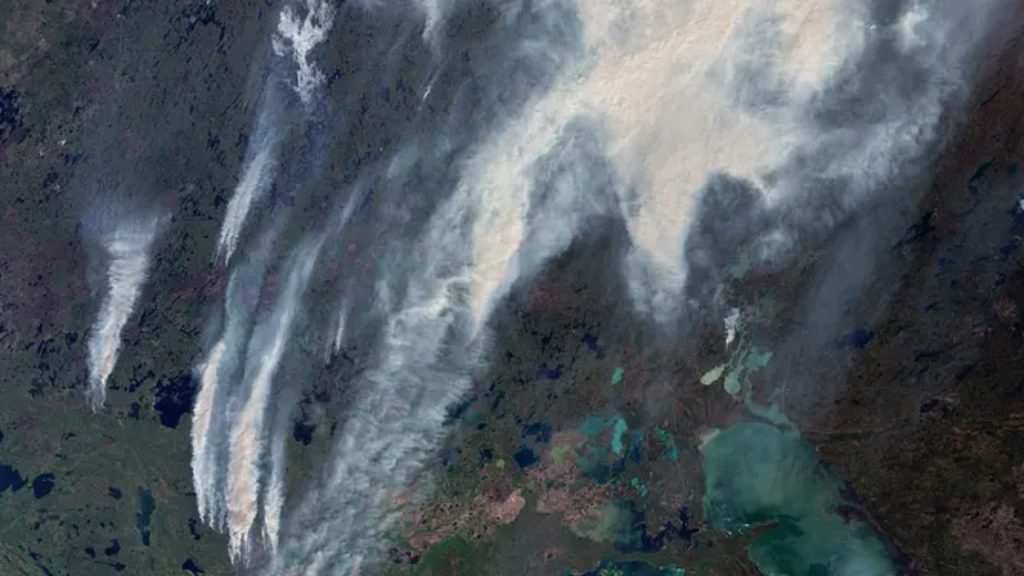
Massive, uncontrolled wildfires in Canada have sparked a growing public health crisis across the Upper Midwest in the United States, as thick smoke from the blazes drifts southward into states like Minnesota, Wisconsin, and Illinois. Officials are warning of dangerous air conditions and have issued air quality alerts urging residents to take precautions, especially those with respiratory issues.
Wildfires Rage in Manitoba and Saskatchewan
The fires began spreading rapidly across Manitoba and Saskatchewan earlier this week, forcing thousands to evacuate as dry conditions and high winds fueled the flames. As of Thursday, over 491,000 acres have burned in Manitoba alone, with officials declaring a state of emergency across several fire zones.
According to The Washington Post, roughly 17,000 people have been forced to leave their homes in affected Canadian communities such as Flin Flon, a city near the Manitoba-Saskatchewan border.
These wildfires are part of a worsening annual trend in Canada, where fire seasons are growing longer and more intense, fueled in part by climate change.
Smoke Spreads to the United States
The smoke plume, carried by prevailing winds, has now reached the Upper Midwest in the U.S., significantly deteriorating air quality across multiple states.
The Minnesota Pollution Control Agency (MPCA) issued an air quality alert on May 29 for northeastern Minnesota, including cities like Duluth and the Iron Range. The alert warns that fine particle pollution (PM2.5) levels have reached unhealthy levels for sensitive groups and could affect even healthy individuals with prolonged exposure.
In Wisconsin, state officials have also reported hazy conditions and visibility issues in Milwaukee and surrounding regions. The Wisconsin Department of Natural Resources continues to monitor air quality via their Air Quality Monitoring Network.
Even Chicago, Illinois, is experiencing noticeable haze and reduced air quality. The Illinois Environmental Protection Agency has yet to issue formal alerts but is monitoring the situation closely.

Health Warnings Issued
Health experts are warning the public to take the situation seriously, especially those who are more vulnerable to air pollution.
Dr. Karen Erickson, a pulmonologist in Minneapolis, says exposure to wildfire smoke can aggravate conditions like asthma, chronic bronchitis, and heart disease, and may even cause symptoms in otherwise healthy individuals.
Recommended Safety Measures
To minimize exposure, officials recommend:
- Staying indoors as much as possible, especially during periods of visible haze.
- Using air purifiers to improve indoor air quality.
- Wearing N95 masks if you need to go outside for extended periods.
- Avoiding strenuous physical activity outdoors.
- Keeping windows and doors closed until air quality improves.
Real-time air quality information for affected areas is available on the AirNow.gov website, a resource jointly run by the EPA, NOAA, and other government agencies: www.airnow.gov/
What’s Next?
Meteorologists expect the smoke to continue moving southeastward through the weekend, potentially affecting more areas across the Midwest and Northeast depending on wind shifts. Some improvement in air quality may occur if rain moves into the region early next week.
In Canada, firefighting crews are struggling to contain the blazes amid high temperatures and limited rainfall. Additional reinforcements, including military personnel, have been deployed to assist with evacuation efforts and firefighting operations.
A Growing Pattern
Experts warn that events like these are likely to become more frequent and severe. Canada experienced its worst wildfire season on record in 2023, and early signs point to another dangerous summer in 2025.
Climate scientists say higher average temperatures and persistent drought conditions are key contributors to the worsening fire seasons in North America. Without significant policy shifts and global emissions reductions, both the U.S. and Canada are expected to see even greater wildfire-related health impacts in the years ahead.
